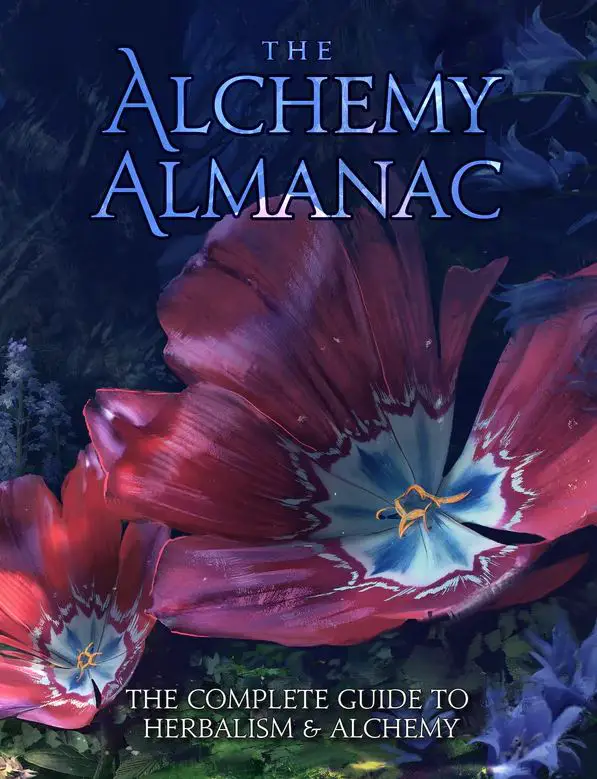D&D 5e Alchemy Almanac featured art is provided by heavyarms, the publisher and provider of content in this review article. This article contains affiliate links that put gold in our coffers.
D&D 5e’s crafting system does not satisfy players. Roleplayers want to gather plants, craft potions, and find uses for monster parts! This sponsored article reviews the pain point of the crafting and alchemy system of D&D 5e and how The Alchemy Almanac (3rd-party) supplement fills that need for players who are willing to drive it.
You can select a point in this outline if you want to skip ahead to a specific section of my review:
— D&D 5e’s Alchemy System Disappoints Players
— Why Isn’t D&D 5e Alchemy Better?
— Is “The Alchemy Almanac” by heavyarms the Answer?
— Running a Game with the Alchemy Almanac
— Harvesting Plants and Monster Parts
— Herbalism and Medicine
— Alchemy Potioncraft and Potions
— The Arcanum Guild of Artisans
— New Fieldcraft and Alchemy Character Options
— Pros & Cons
— Reference Tables, Design Notes, and FAQ
— Where to Buy The Alchemy Almanac
Before you get too far, what’s your existing opinion on D&D 5e crafting?
D&D 5e Disappoints Players Who Want Alchemy
Wizards of the Coast designed D&D 5e with outrageously long and expensive requirements for crafting magic items. Alchemy was completely ignored apart from magic item crafting. The game has alchemist’s tools and an herbalism kit, but their uses are disappointingly sparse. Xanathar’s Guide to Everything later provided new uses for tool proficiencies, but the craftable items for alchemists remained paltry and pathetic in that book.
Along with alchemy, D&D 5e doesn’t enable DMs and players to harvest components from dead monsters, gather plants for herbalism, or discover ingredients for new potions. Unfortunately for D&D 5e, players love crafting options. Many other TTRPGs and video games have some kind of crafting system. I’ve spent countless hours gathering ingredients for my Skyrim character’s Alchemy studies.
I wonder why Wizards of the Coast continues to focus on “easy” character options like subclasses and spells instead of refining D&D 5e’s alchemy and other crafting systems…
Why Isn’t Alchemy Better in D&D 5e?

Wizards of the Coast has not explained the answer, but I can speculate on several evident reasons. Alchemy is complex. WotC would need to devote many resources and brains to create a workable, robust, sustainable crafting system. They’ve already created a system that they don’t see a reason to change.
Current crafting in D&D 5e takes a long time and heaps of gold. WotC borrowed much of D&D 5e’s design from past editions without adjusting for modern rationale. Dungeons and Dragons games had more downtime in old-school campaigns. The original game was slower with more time between episodic adventures. The game was a west marches style where players could have many characters and use them differently all the time. There was also more of an assumption of character death. The modern 5e game scene involves characters who are more integral to the plot, and those characters follow a plot that often resolves within several months. If crafting items can take a year, there’s no way a player can use that system.
WotC probably knows that it’s difficult to expand the alchemy system without creating more work for DMs and confusing homework for players. They’re not in the business of releasing books with an audience as specific as players who are willing to put in the work to implement the system themselves. The sad truth is many players leech somewhat on their DMs’ wealth of knowledge without learning the rules themselves. Creating another heavy lift for DMs is absolutely a concern.
Approachable Alchemy Systems Are Difficult to Design
Tracking inventory isn’t fun for many players. It doesn’t take long browsing the D&D community to realize players don’t enjoy rules for inventory counts, encumbrance, or inventory space. They hand-wave that stuff and choose to have infinite ammo for their hand crossbows while carrying as much loot as they can find. WotC knows that designing a tracking system is extremely hard, and hard things aren’t their strength. I’m not trying to slam them, but they definitely rely on artwork and concepts to sell books, not the depth and quality of the material. They also have other projects in the works for the 2024 updates they’ve been hyping up.
Most of all, Wizards of the Coast doesn’t think a better alchemy system will make them money compared to the opportunity costs. They have a pulse on what sells books and makes the game popular. They also don’t like to make their older books obsolete like this because then folks will be less likely to buy those old books. Additionally, from what I’ve heard, Wizards of the Coast isn’t a beacon of employment quality. I often hear about underpaid employees for the area they must live in, lack of top-talent recruiting, and high employee turnover. All my impressions on WotC/Hasbro as an employer are second-hand, so don’t take this as gospel.
If Wizards of the Coast won’t develop the alchemy system, it’s up to third-party publishers to do it. This is where we get to the topic of this article’s sponsor, heavyarms.
Is “The Alchemy Almanac” by heavyarms the Answer?
In short, yes, I love this system. I’ve thoroughly reviewed it, and I’ve received approval from my current DM to implement it. Having said that, there is a well-defined target audience for The Alchemy Almanac. Here is what the product promises to do and how I interpret it, so you can identify if it’s for you before I expound on it (bold format added for emphasis):
- “Plug-and-play crafting rules that put no extra work on the Dungeon Master“
- Easy DM buy-in.
- “Fun and interactive money-sink for players“
- Players enjoy it and can finally spend all their gold.
- “Recipes for hundreds of potions, new and old, with unlimited capacity for additional recipes and ingredients“
- Plenty of material in the material, and space to add to it.
- “Rules for buying and selling, including price lists, and rules for dynamically populating shop inventory with a single dice roll“
- Worldbuilding consistency and clarity.
- “No arbitrary time or level-gating“
- Your chances for success can increase, but any character can use these rules at level one.
If these offerings sound enticing to you, you’re going to be very happy with The Alchemy Almanac. Heavyarms is an experienced, professional third-party game designed. After reading the Alchemy Almanac thoroughly and picking it to pieces, I can honestly say I love the product. I’ll go through each section and explain why this product is so exciting.
Here’s What We’ll Cover
As a side note, the PDF contains original artwork, easy formatting, and bookmarks for quick navigation. I always want to see these things in 3PP products. They’re icing on the cake. Additionally, though the product’s name refers to alchemy, it covers peripheral topics I mentioned earlier.
There are seven sections to the PDF that I want to describe for you:
- Running the game with this alchemy system.
- Fieldcraft: gathering plants and harvesting creatures.
- Herbalism: making medicine.
- Alchemy: potioncraft and item descriptions.
- The Guild: rules for participating in a guild and advancing within it.
- Character Options: subclasses, feats, magic items, Warlock Invocations, and Artificer Infusions.
- Appendices: reference tables, design notes, and FAQ.
By the way, “heavyarms” spells his name in lower-case, so don’t let my writing confuse you when I don’t capitalize his name as a proper noun.
Running a Game with the Alchemy Almanac (DM Info)
This is one page of info to review relevant rules and explain new ones. This is the section of existing rules of D&D 5e that are worth reviewing. The section also mentions optional rules for combining potions.
This section introduces a new mechanic for an extended rest. An extended rest requires one week. Extended resting prevents a character from benefiting from multiple potions of the same type too frequently.
There’s also a new mechanic for “burning” or setting a creature on fire. Creating a condition for this effect saves a lot of time and headaches. I wish D&D 5e had more conditions; spells and magic items need not be so wordy.
Lastly, a section is provided to help DMs adjust prices and costs based on party level, income per level, and assumed “net worth” of the party by certain levels.
Harvesting Plants and Monster Parts

Before we can create potions, we need to learn how ingredients are gathered. Heavyarms implemented designs that I completely agree with for quickly describing a DC that increases with repeated attempts. He also describes new kits for harvesting from monsters and what’s in those kits. Even though the product is clearly focused on alchemy, the standout content is definitely the herbalism and harvesting system and its medicines (more on that later) that can be crafted. This is easily my favorite part of the product.
He also explains ways that the gathering process will broadly function. In addition to the section on running the game, this is the main section that the DM needs to read. This brings the total required reading for the DM to three pages. The DM might also browse other parts of the PDF, of course, but this is the only portion that I’d say a DM should read. I say the DM should read this section because it involves monsters, terrain, and how gathering ingredients will typically work.
Fieldcraft with Your DM
DMs need to be aware of how the terrain will affect a player implementing this system. Urban terrain won’t help the crafter, so the DM should clarify if the campaign will mostly be urban.
There are also rules for harvesting from incapacitated monsters that aren’t dead, so the DM needs to know the player might attempt surgery. Adventuring party groups can also work together to use what resembles the Help action on a harvest attempt. There’s also guidance on what kind of skill checks should apply to different creature types. For example, Religion is best for celestials, fiends, and undead.
Plants can be harvested with simple rolls during downtime and resting. Flora is gathered with Intelligence (Nature) checks . Players can resolve these rolls entirely on their own without DM intervention or judication. There are chances to fail or gather the ingredients that were not hoped for, so multiple attempts may be required for players to get what they want.
Characters must be proficient with a harvesting kit to attempt harvesting monster parts.
Herbalism and Medicine
Now that you’ve learned to gather plants and monster parts, you can use them to create medicines. There are different categories of medicines that use primary components to create them and second components to enhance them. Some medicine formulas allow them to become permanent when you’ve completely progressed through the Arcanum guild (more on that later). The potentially permanent effects can not coexist, so a player can only benefit from one permanent effect from The Alchemy Almanac.
Crafting medicine requires an Intelligence or Wisdom check with an herbalist kit. You must be proficient with an herbalism kit to attempt medicine crafting. DCs are adjusted based on the medicine you attempt to craft. The difficulties are quickly referenced with a five-star system that I love. Gold costs are pretty mild, so the main costs will be the gathered ingredients (which are not guaranteed).
I also like that the ability scores that are used in this PDF vary depending on the type of craft. This means certain classes will specialize in the craft of choices since they have better modifiers for the rolls.
Medicine Upgrades
There is also an “upgrade” system for all medicines with the five-star system. My favorite part of this system is that it comes front-loaded with an explanation for how the effects will scale and upgrade. This means each medicine/potion is extremely streamlined without having to repeat the same information over and over again, as 5e is prone to do. Reaching the highest ranks of the Arcanum Guild will allow characters to craft some medicines with indefinite durations. Medicine that benefits a character indefinitely will cease to benefit the character if another medicine of indefinite duration is used by the character.
This section provides many medicines to craft. Not only is there a large quantity of them, but the quality is also top-notch. I found myself imagining possibilities and uses for each medicine type with few exceptions. Some of the medicines provide extremely powerful effects, but the ingredients are difficult to acquire. A player can gain Legendary Resistances or cast high-level spells like Wish (but they’ll need to take a unicorn’s horn and not be evil which may not bode well for them).
Many medicines are included in this section. They’re imaginative and well-designed, so I thoroughly enjoyed reading through them.
Alchemy Potioncraft and Potions

Crafting potions with alchemy involves alchemical bases and reagents. Alchemical bases are available for purchase from apothecaries, and the most expensive bases cost 200 gp.
Each reagent is based on an element. Fieldcraft rules in chapter two apply to gathering reagents. Surprisingly, this alchemy system is far simpler than the herbalism system in chapter two. Proficiency with alchemist’s supplies is requisite to attempt alchemical crafting.
Crafting requires one hour and can overlap with resting. Intelligence is the ability score for crafting checks, and the DC to successfully create a potion depends on the potion’s strength (potency, not the Strength ability score). An optional rule is applicable if a crafting check fails by three or less. You can still successfully craft the potion, but it comes with unpredictable side effects (which can include death).
What Alchemical Items Can We Craft?
One of the first things you’ll notice is that you can craft a spell-storing potion. Spell-storing potions may contain spells of first level up to seventh level. There are some spell and guild rank requirements to use spells leveled 6-7.
Other craftable potions include some from D&D 5e’s SRD (can be used in third-party content), but many of the alchemical items are new. Some of my favorites are the Flash Pellet, Elixir of Life, Foehammer, Potion of Wizard’s Bane, and Stafford’s Boon. You can also craft wondrous items like a Philosopher’s Stone. Several potions and alchemical items are incredibly useful or outright powerful, but they’re difficult to craft. Building your character to have a healthy modifier with alchemist’s supplies will serve you well.
I’ve never seen a system like this. It leaves unlimited room to design your own alchemical items while remaining simple to plug and play in your game without grinding the game to a halt or breaking the world you’ve built.
D&D 5e Alchemy Arcanum Guild
Heavyarms uses the Arcanum guild in several of his products, including the Armorer’s Handbook. Artisans join the guild to secure supplies and learn from the best.
Aside from ingredients and crafting checks, guild rank is one of the few gatekeeping mechanics to creating the most powerful items in the Alchemy Almanac. Player characters can spend several weeks for a tuition term and pay light gold tuition costs (much more affordable than IRL university). At the end of each term, they can attempt to craft an alchemical item or medicinal item. Success results in progressing up one rank. There are five ranks from novice to master. Attaining a rank comes with a +1 bonus to crafting items of the rank’s equivalent strength and lower.
Masters receive an Arcanist’s Medallion. The prestigious item requires attunement but does not count against a character’s max of three attuned items. Master herbalists can create medicines that potentially last indefinitely. Master alchemists can create spell-storing potions of sixth and seventh levels.
Guild Benefits
Guild membership has additional perks. Each party member with membership can roll to stock a guild shop dynamically. Higher ranked members roll larger dice. Any character can purchase finished items from the build, though there are limitations on the strength of items purchased according to PB. Guild merchants will also purchase relevant items at 20% retail price.
There are suggestions for downtime activities performing guild tasks. Research, study, and other tasks can result in complications or celebrations! The DM will notice ample opportunity to introduce rivals to the story with the guild. I recommend DMs read about the guild so they can decide if the guild will fit in the world. I encourage alchemy in worldbuilding and within the guild to be kept at a low-magic status, meaning it’s not rampant and understood (just my opinion).
D&D 5e Alchemy and Fieldcraft Character Options
I was surprised and delighted to receive character options in this supplement! You get a Cleric subclass for the Artifice Domain, a Druid subclass for the Circle of the Grove, and a Wizard subclass for School of Potioncraft. There are also feats, magic items, Eldritch Invocations (Warlocks), and an Artificer Infusion that are new and suited to alchemy.
New Subclasses with Crafting Specialties
The Artifice Domain Cleric is basically a Cleric who functions with tastes of Artificer Infusions. Think of it in the same way an Arcane Trickster dabbles in magic a bit for the Rogue. It’s a simple but smart design choice.
Circle of the Grove Druid would make a fantastic subclass regardless of whether the DM allows the new alchemy and herbalism systems. You can use plant-based magic to greater effect by teleporting through their areas and expend Wild Shape to cast plant spells with greater efficacy. You can eventually transform into a Treant from the Monster Manual (so COOL)!
Wizards from the School of Potioncraft spend spell slots to fortify alchemy crafting checks. In other words, they become consistent and reliable alchemists. All their subclass features are based on alchemy, providing resistances to many conditions and the ability to quickly drink one potion (two potions at level fourteen).
Other New Character Options
One Eldritch Invocation bolsters the Pact of the Talisman’s ability-check-buffing dice, increasing them by one size. The other allows a Warlock to copy the effect of a potion that they see someone drink nearby. The Artificer Infusion assists the Alchemist Artificer in adopting the Alchemy Almanac into its Experimental Elixir feature.
The new feats come with +1 stat boosts, x2 PB for a given crafting tool, and one or two abilities that improve the given crafting type and its associated fieldcraft method. They’re welcome additions to the game. I’d almost certainly pick one if my character build didn’t already lend to crafting.
Lastly, several magic items are provided that help monster harvesting, flora gathering, and other crafting aspects. They make excellent gifts to player characters, so DMs should absolutely check them out on their one-pager.
Reference Tables, Design Notes, and FAQ
This supplement wouldn’t be complete without easily referencable tables! You can look up fieldcraft by terrain, practical info about plants, relevant creatures’ biological loot, guild shop inventory, and success/failure tables.
You also get a line-item tracking sheet for ingredients and crafts. There is a printer-friendly version of the same inventory tracker. You can track inventory with the PDF fields or print a sheet to use with a trusty pencil.
Design notes and FAQs are provided, too. Some of the common questions are about what temporary modifiers can apply to fieldcraft and crafting rolls.
All the information provided is extremely accessible and helpful. Players will reference this section frequently. I recommend DMs to browse appendix C, so they know what monsters will be of interest for harvesting components.
D&D 5e Alchemy Almanac: Pros and Cons
Pros:
- It’s easy for DMs to implement if players are passionate and proactive.
- The system provides useful ways for players to spend gold.
- DMs can find new rewards that won’t break the game, but they’ll motivate the players.
- Plenty of new items and ideas apart from the crafting systems.
- Synergy and consistency with another premium third-party content piece.
Cons:
- Being stuck in a single environment or urban area may diminish enjoyment of the system.
- DMs don’t need to do much with the system, but they can accidentally gate a lot of content.
- Players disinterested in the guild may need an alternative system to master their craft.
- Tracking inventory and referencing tables could prove too much to juggle for some players, but I can’t imagine a simpler system that wouldn’t also be deeply disappointing.
Where to Buy the D&D 5e Alchemy Almanac
The Alchemy Almanac is sold at heavyarms.com (linked here). It’s currently sold for $17.95 to get the 53-page full-color interactive PDF with bookmarks and hyperlinks.
You can find additional content about alchemy concepts, the Alchemist class, and herbalism by following these links. Cast Message in the comments to let me know if you’re excited about the Alchemy Almanac by heavyarms!




